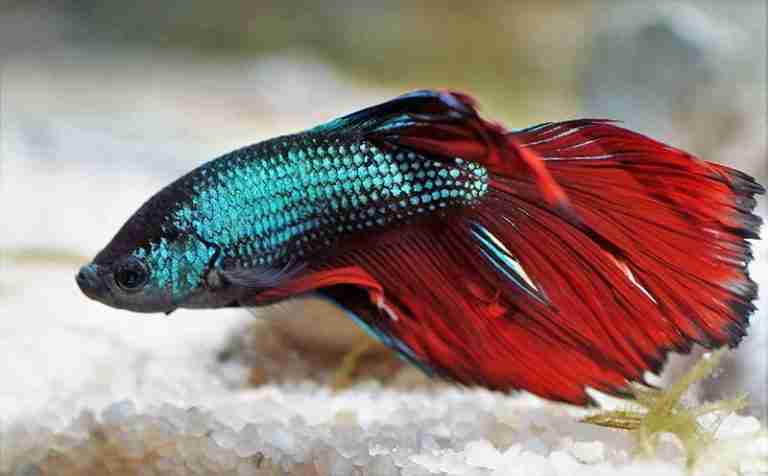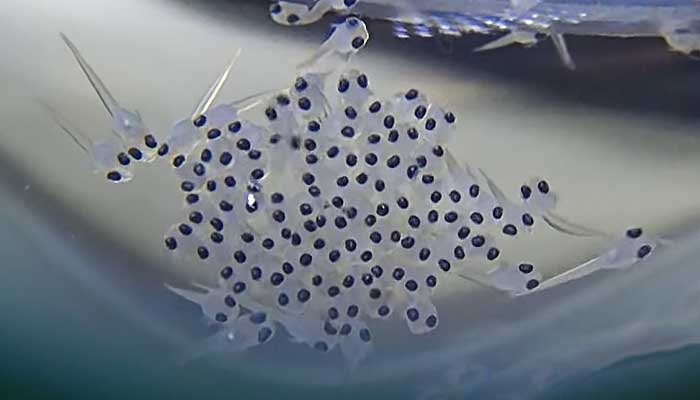What Is A Betta Sorority – Expert Guide And Tank Setup
Whether you are new to keeping betta fish or have had them before, the idea of a betta sorority tank might be an exciting new venture to try.
A betta sorority is a group of female betta fish kept together in the same tank. You should set up a sorority aquarium in a specific way to increase the likelihood of a successful sorority bond taking place. It is best to keep sororities to 3 or 5 females to reduce the chance of fighting.
Although female betta fish can be territorial, and there is always the potential for aggression and fighting, female betta are far more sociable than their male counterparts, making creating a betta sorority possible.
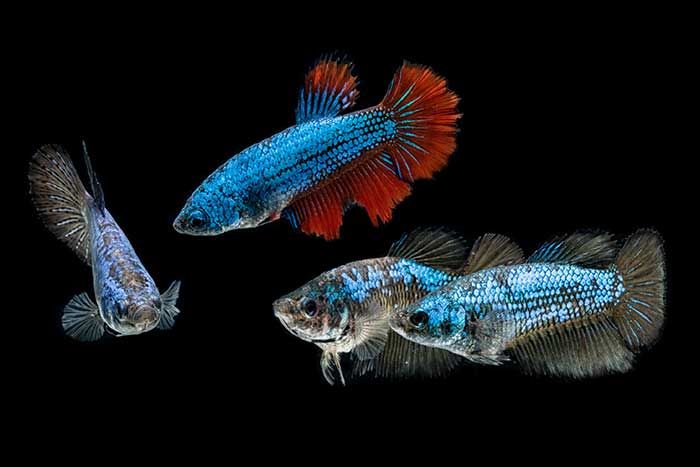
Throughout this article, I’ll cover the following:
1. What is the definition of a betta sorority?
2. What is the best way to start a betta sorority group?
3. Are betta sororities a bad idea, especially considering that betta fish are known for aggression and fighting?
4. How to set up a betta sorority tank, including the ideal size of the tank, planting the tank, and how many bettas you should keep together.
5. I will end with some betta sorority tips.
Many people keep betta sororities quite successfully, but sadly there is no guarantee that they will get on. Hopefully, if you follow the steps in this guide, it will better equip you for success.
What Is A Betta Sorority?
A betta sorority is a collection of females kept together in one tank. Keeping a sorority of betta fish is an excellent solution if you are a breeder because you will only need to add a male when the time is right.
Although it is acceptable to add a male into the female’s tank, it is far more common to put the females in with the male because when a male betta is ready to mate, he will begin constructing a bubble nest inside his tank.
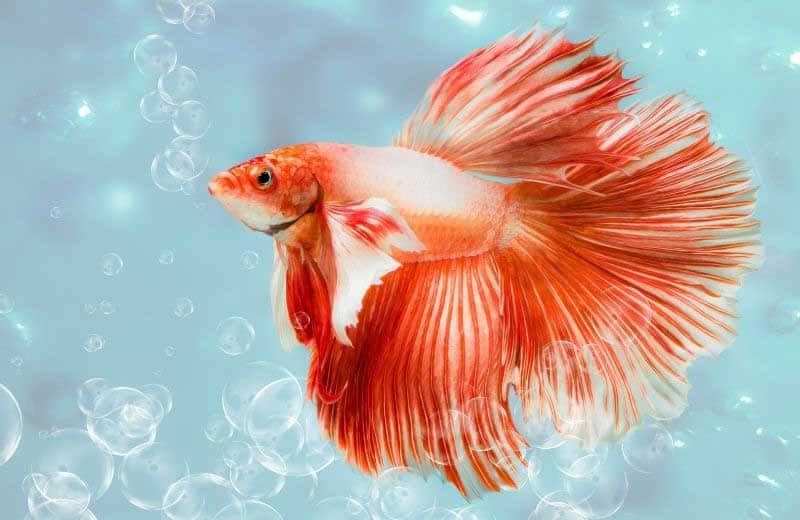
If you keep male bettas, you should only have one per tank because of the danger of them fighting. Male betta fish are highly territorial, and two male betta fish will battle, sometimes to the death, due to this.
Although it is not typical, female betta fish will fight occasionally. Females are often significantly more docile than males, which is why they can be kept together in small groups or sororities.
How To Start A Betta Sorority
There are a few things to think about before starting your sorority of betta fish. Although bettas are one of the easier fish to keep, they do have their own set of requirements.
A little bit of research into betta fish care can help you avoid many pitfalls and ensure that your bettas stay healthy and happy in their new environment.
When starting a betta sorority, the first step is to set up the tank. Setting up the tank is probably the most critical aspect of keeping a successful sorority, so I will explain how to do this correctly a little later on.
Can I Add More Bettas To My Sorority?
It would be best if you introduced all of the female bettas into their new sorority aquarium at the same time. Adding an unknown female to an already formed sorority can unbalance things, and they may not take to the new addition. By introducing all females simultaneously, you can significantly reduce the chance of any problems occurring, and it will be much easier to monitor them for stress and illness.
Another recommendation is to introduce your females from a young age, as young fish are far less likely to fall out, and this will allow them to become familiar with each other as they grow into adults.
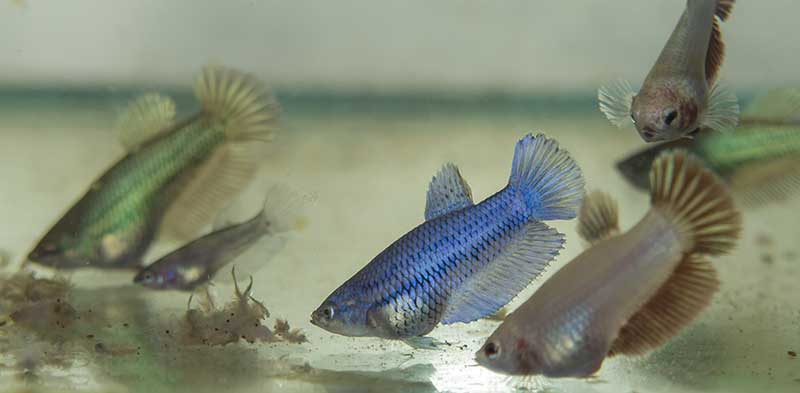
Adult fish will undoubtedly have a pecking order, so don’t be shocked if minor fin nipping or fighting occurs. You will need to keep an eye on how each betta is doing in the first few days. If you introduce a weak female, it may become an easy target and should be removed quickly.
If you do not experience any difficulties after one week and your new betta sorority seems settled in its new home, it is unlikely that problems will develop later on.
Are Betta Sororities Bad News?
Betta sororities are not a bad idea, and when they work out, they are an excellent idea. It’s the perfect setup for breeders, a good community tank setting, it’s much easier than keeping several tanks, and that’s just a few of the positives. However, there are always potential pitfalls in most things.
Below I have listed some of the positives and negatives of starting a sorority of bettas.
Positives Of Starting A Female Betta Sorority
Female betta fish are more sociable – As I have already mentioned, female betta fish are much less likely to be aggressive and, therefore, should embrace the opportunity of some company from other female bettas. The key to keeping a successful betta sorority is to give them the space to keep out of each other’s way when they want some alone time.
Sorority bettas will exhibit more natural behavior – Because female betta fish are less aggressive than male bettas, they will exhibit their natural behaviors of showing off to potential suitors. By having multiple females of different colorations and fin types in the same tank, you create a wide range of visual stimuli for them to show off to each other!
Betta fish are intelligent and will be easily bored when alone – The intelligence of betta fish is often underestimated by betta owners. Betta fish do not fare well when they are kept alone and will get bored quickly if they don’t have other bettas to interact with. You can tell when a betta is bored or unhappy because they lack the coloration of health and instead will look dull.
The setup is cheaper – Setting up a betta tank is not going to break the bank, but it is also not cheap. Setting up one tank to keep a betta sorority will be far more affordable, even when feeding them.
Female bettas in a sorority will often display better colors – A betta fish’s colors are usually only fully expressed when it feels safe in its environment, and this is undoubtedly the case when female bettas are kept in a sorority.
A Betta Sorority Is Ideal For Breeding Purposes
Having a sorority of betta is the ideal solution for breeding purposes. Because the group of girls has already accepted each other, introducing a male should be less of a challenge.
Choosing to introduce the females into the male tank, you can do them one at a time or all at the same time. You will have several fish to try until they are well-suited and decide to mate.
Negatives Of Starting A Female Betta Sorority
Some female bettas in a sorority may not get on – It is always possible that some of the female bettas in a sorority will not get on and may display aggression towards each other. This can be controlled by having more than enough hiding places for all your female bettas, but it may still occur.
If the aggressiveness continues, one of the females will have to be relocated to a separate tank before any damage can occur and to avoid causing other members of the sorority to become distressed.

Diseases and parasites can spread more easily among a sorority – When bettas are kept in a sorority, it is more likely that any disease or parasite, such as white spot or betta fin rot, will spread. Just one fish carrying an infection can potentially wipe out a whole tank.
You can stop the disease from spreading and causing devastation by quarantining symptomatic bettas as soon as symptoms appear. This is not necessarily an issue specifically related to betta sorority tanks, it is relevant to all community fish tanks.
Maintaining a betta sorority takes up a lot of tank space – Keeping a betta sorority will require a bigger tank, which will take up much more space. If you have a room big enough, this will not be a problem and can be an attractive feature. Dependent on how many female bettas you want together, you will probably need a tank of 30-50 gallons or bigger.
How To Setup A Betta Sorority Tank
Setting up a sorority aquarium is much like setting up any aquarium. Still, you will need to consider the additional requirement for space and provide plenty of hiding places for your betta when they want some privacy. The correct aquarium setup should positively impact how the sorority reacts to each other.
Male bettas are the most territorial, quickly defending their territory from another male, which is related to mating and breeding behavior. Female bettas are also territorial to a degree and will need their own territory when introduced to their new tank.
Providing enough space for each girl in the sorority to claim a portion of their own domain and using living plants to separate these potential territories will go a long way toward creating a peaceful atmosphere.
The addition of live plants will offer hiding places for each betta while also concealing their view of one another as they stay in their section of the tank. Plant coverage should provide a sense of security and enable stress-free living among the sorority.
Betta Sorority Tank Size
Because of a bettas temperament, I would not recommend starting a betta fish sorority if you only have a general aquarium hobby. Betta fish are relatively easy to keep by themselves, but keeping a sorority, as I have already explained, does become a little more complicated.
If you are ready and up to the challenge, the most important part of starting your betta sorority is choosing the correct size betta tank.
Betta owners have a common misconception, especially those who have not conducted enough research, that betta fish are happy living in tiny tanks or bowls. It is also not helpful when many retailers will happily sell starter betta kits that are too small and offer poor advice to their customers.

Betta fish do like space. The cause of this misunderstanding is that wild betta fish can often be found living in small puddles. These small areas of water are usually isolated pockets in rice paddies or other wetland areas of southeast Asia where there is a concentration of rainfall.
These small puddles will connect up most of the time, forming bodies of water that can stretch over several acres, allowing plenty of room to swim around.
How Many Female Bettas In A 10 Gallon Tank?
A 10-gallon tank of standard dimensions is only suitable for one female betta. If you choose a shallower tank that covers a broader area, you should comfortably manage two bettas, and at a push, this is the absolute minimum tank size for three female bettas. Use your judgment and give each betta enough space.
How Many Female Bettas In A 20 Gallon Tank?
Three to five female betta can be housed in a 20-gallon tank, and this again depends on the dimensions of the tank itself. A taller tank will be very cramped for even three female betta fish to live comfortably together. A shallower tank will have a wider area and should provide enough room for up to five maximum. I would recommend setting up your tank and then making a judgment yourself.
Best Plants For Betta Sorority Tanks
Plants are vital when you are creating a sorority of betta fish. In the wild, betta fish will rely heavily on plants for cover, where they will hide from potential threats.
The simple addition of some live plants can make a huge difference and provide that little extra comfort and avoid excessive stress and encourage less aggression.
The best type of plants for betta tanks are floating plants such as Cabomba and Hornwort. These plants will help to create a natural barrier, allowing the bettas their personal space. Anubias or java ferns are also a good choice as they are very hardy and can withstand the betta’s occasional grazing on them.
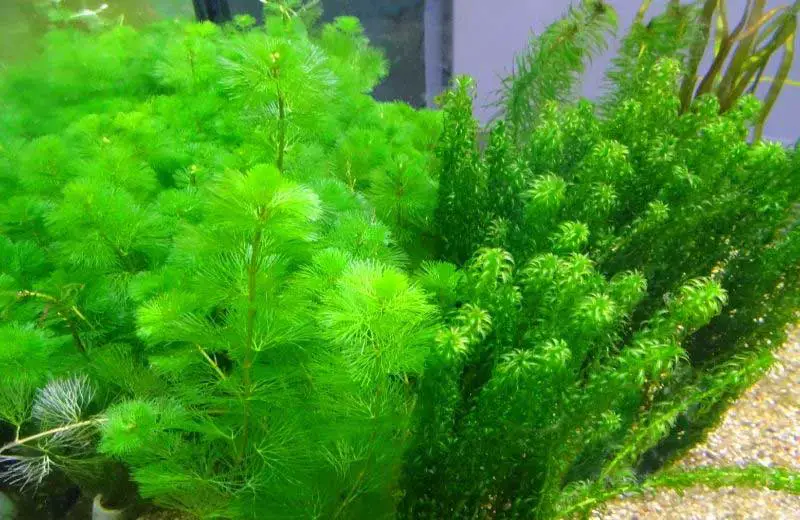
How To Care For A Betta Sorority
Caring for your sorority will be much like caring for a single betta fish, except that you will need to monitor them a little more closely. Having more than one betta in the same aquarium comes with some challenges, but managing just one tank can also be a little easier.
Feeding Your Betta Sorority
When feeding several betta fish, more waste can build up in the tank from uneaten food, quickly leading to poor water quality.
Betta’s stomachs are around the same size as their eye, so each will only require a small amount of food to keep them healthy. Underfeeding a little will not harm your betta fish, in fact, it can be beneficial to avoid feeding them for a day or two per week while their digestive systems relax.
Betta fish are mostly carnivorous, so you should vary their diet by adding some live or frozen food. Your betta will eat a little vegetation from time to time as this will help to avoid constipation from occurring.
Cleaning A Betta Sorority Tank
Regular tank cleaning will be necessary as there is a higher risk of infections occurring in a community tank. With many bettas housed together, poop and other waste will build up much more quickly. Having an adequate filtration system will help keep the water parameters settled in your sorority tank.
When caring for your betta sorority, especially in the beginning, you will be looking for any signs of fighting or fin-nipping. Having more than one betta in the same tank is never going to be completely straightforward.
I mentioned earlier that there would likely be a pecking order form within the sorority, but you must catch any ongoing aggressive behavior early on. It is often best to move the aggressor to a separate tank to see if more aggression occurs between the other fish.
Betta Sorority Tips
Although I’ve covered everything you will need to know about setting up a sorority of bettas, I will leave you with some tips to help you to get the most out of the experience.
Make Sure You Have An All-Female Sorority
Do you know how to sex your betta fish, especially from a young age? Although it seems pretty obvious, you will need to ensure you do have an all-female sorority. If you are buying from a pet store, this is done for you, however, mistakes sometimes happen.
Female Bettas Have Shorter Fins – The easiest way to tell a male betta from a female is from the fin length. Males tend to have much longer dorsal (top), ventral (underside), and caudal (tail) fins producing a plumage that is much larger than that found on female bettas. It can take six months to a year before fins become fully developed, so this is not a reliable way to sex a young betta fish.
Female Markings – Some markings will differ when comparing male bettas to females. Female betta fish have an ovipositor, a tiny white dot located on their underside near the ventral fin nearest the head. The ovipositor is where eggs are dispersed during the egg-laying process.
Although male bettas do not have an ovipositor, young males can develop a false white spot that helps protect them from larger predatory males. This spot will disappear in time, but it can make it difficult to tell male bettas apart from females.
Coloration – Female bettas are typically less colorful than males, which, combined with fin length, can be an easy way to sex them successfully. Again, this is only possible after a few months because coloration takes a little time to develop.

Stress can also lead to stronger or weaker coloration, and stress stripes may appear horizontally along the betta’s body. Stress stripes are a good sign that something is wrong with your betta, and if you believe yours may have them, I would suggest reading What are Betta Stress Stripes and How to Get Rid of Them for further information.
Body Shape – Female bettas will often have a shorter, rounder body shape than males, who are usually longer and thinner.
The longer body of the male is better suited to larger fin development, and the shorter body of the female makes carrying and laying eggs much more manageable.
Bubble Nest Building – It is common to find male bettas building a bubble nest within their own tank, especially when ready to mate.
Building a bubble nest consists of mixing saliva and other materials and then forming bubbles that will often be found floating at the surface or under some plants. The bubbles are to keep the eggs safe once produced by the female and inseminated by the male.
Many people believe that only the male will build a bubble nest, and although this is true in most cases, a female can build a bubble nest if she so desires. It is very unlikely because she has no reason to, but the ability is there.
Betta fish have a labyrinth organ that enables them to breathe oxygen from the air when they need to, and it is this organ that allows them to blow bubbles and build this unusual type of nest.
Male Betta Fish Are More Aggressive – I’ve talked a lot in this article about how aggressive male betta fish are in comparison to female bettas.
Although both can show aggressive behavior, a male will show this more readily and can be easily provoked by holding a mirror in front of him or placing a finger in the tank to follow him around.
A betta that flares its gills at its reflection is most likely a male. If it’s a female betta flaring aggressively, it’s also a telltale sign that this betta would not mix well in a sorority tank.
Start With A Small Betta Sorority
Don’t overstretch yourself, and stay within your comfort zone. The number of fish you choose to have within your betta’s sorority will directly impact its success.

Starting a small betta sorority will be far easier when dealing with minor hiccups, and the solutions you may need to find will often be much more straightforward.
A larger sorority of female bettas will come with many more challenges and a much higher risk of failure.
Use An Adjustable Flow Water Filter
Betta fish prefer weaker water currents that they will not have to swim against. By using an adjustable flow filter, you can provide a gentle flow, just enough to circulate the water without upsetting your betta sorority.
Keep An Eye On Water Quality
Poor water quality is the quickest route to failure. Poor water quality can cause disease or parasites, which will spread quickly among fish and can devastate a tank.
A decrease in water quality can also cause stress in betta fish, which may compromise their immune systems.
A simple increase in ammonia levels caused by a build-up of rotting food waste and poop can lead to an increase in nitrates and nitrites, helping your tank become a breeding ground for many harmful bacterias and parasites.
Good filtration, plenty of live plants, and a regular cleaning schedule will be enough to keep your water levels in check.
Use A Big Tank For Your Betta Sorority
I’ve already talked extensively about choosing the correct tank size for your sorority, but I feel that it’s such an essential factor that I will mention it again.
The larger the tank, the easier your sorority will be to look after. Not only does a larger tank give each member of the sorority more space to move around, but concerning water quality, a larger tank will help keep the water conditions more stable and will slow down the spread of disease and illness.
It is naturally assumed that by choosing the bare minimum tank size, it will be easier to manage, but the opposite is true in just about every scenario, especially when keeping more than one fish in a tank.
Wrapping Up
I have given you as much advice as I can, and the rest is up to you. Starting your own betta sorority tank is not hard, and if you follow my advice and keep things simple, there is no reason why you should fail.
Remember to keep a spare tank in case any issues arise, and if you choose to use your sorority girls for breeding, this spare tank will certainly be useful for any new betta fry that you may get rewarded with.




